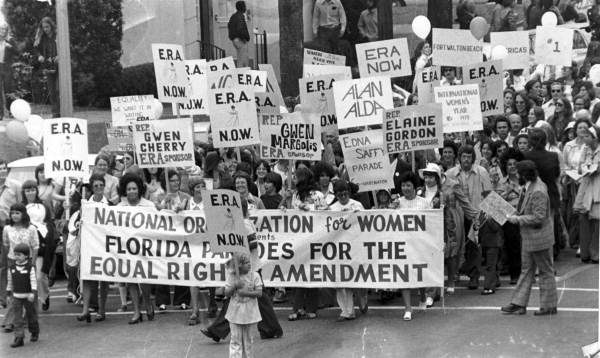What does Equal Rights Amendment ratification in Virginia mean for its chances?

Virginia Del. Jennifer Carroll Foy, seated center, is applauded in the House of Delegates gallery after she spoke for passage of the ERA resolution she sponsored Jan. 15 at the state capitol in Richmond, Virginia. Photo by Bob Brown/Richmond Times-Dispatch via AP.
The Equal Rights Amendment has been battling the numbers since 1979, at which time it fell three states short of becoming part of the Constitution. As of 2020, however, just one state was needed to meet a state count threshold to pass the ERA—that’s until Virginia made history on Jan. 15, ratifying the amendment. Now, the ERA is dealing with a different sort of numbers game: Has the date for ratification passed?
Congress sent the ERA to the states in 1972 with a seven-year ratification window. Amid controversy, Congress extended the deadline to 1982, but no additional states voted to ratify during that period. After decades of dormancy, however, two more states (Nevada and Illinois) ratified it in 2017 and 2018, reigniting the movement.
The amendment is pending before Utah legislature and is expected to be introduced in several other states, but Virginia’s ratification, alone, meets the article V requirement that an amendment be ratified by three-quarters of the states.

The year 2020 is the centennial of the 19th Amendment. A hundred years after getting the vote, what do women’s legal rights and representation look like? The ABA Journal’s yearlong series examines these issues.
Additional Resources
• 19th Amendment Centennial of Women’s Right to Vote
• ABA Commission on the 19th Amendment
That makes 38 the magic number, and both sides are invoking it from opposite ends of the spectrum. Supporters, including a wide swath of constitutional scholars, say the number satisfies the final hurdle to becoming the 28th amendment to the Constitution. Opponents counter that the deadline for ratification expired 38 years ago. Underlying it all is the question of whether a valid deadline for ratification of the ERA ever existed, given that the seven-year limitation appears only in its preamble but not in the body of the amendment, which reads: “Equality of rights under the law shall not be denied or abridged by the United States or by any State on account of sex.”
The practice of putting a deadline on amendment ratification began in 1917 with the 18th Amendment (Prohibition), according to a Congressional Research Service report from 1997. All amendments proposed since then except for the 19th (Women’s Suffrage) and the proposed child labor amendment have included a deadline.
Those 24 words in the preamble recently triggered a series of legal maneuvers. In a preemptive move, attorneys general of three states (Alabama, Louisiana and South Dakota) jointly filed a complaint in December to block ratification of the ERA. Alabama et al. v. Ferriero, N.D. Alabama sought to nullify Virginia’s anticipated ratification and delete the ratifications of five states (Idaho, Kentucky, Nebraska, South Dakota and Tennessee) that previously voted to rescind their approval.
In the Alabama case, defendant David Ferriero was sued in his official capacity as archivist of the United States, a position that requires him to certify a ratified amendment and enter it in the record. That ministerial act officially makes the amendment part of the Constitution. Ferriero said he would not act before Feb. 15 and requested legal guidance from the Justice Department’s Office of Legal Counsel.
On Jan. 8, the Justice Department publicly released OLC’s non-binding opinion, which stated that any future state ratifications of the ERA should not be recognized because they are time-barred and said the five state rescissions should be recorded.
Jessica Neuwirth, an attorney and president of the ERA Coalition, calls the OLC opinion a “desperate attempt to throw a shadow on” what was going to happen in Virginia. She notes that the 19th Amendment giving women the vote wasn’t subject to a deadline. “That’s because [voting] is a fundamental right. Is there a time limit on equality?”
Within days of announcing that he would comply with the OLC opinion, Ferriero was sued again. In early January, an ERA support organization filed a complaint in a Massachusetts federal district court challenging the validity of the original ratification deadline (Equal Means Equal, The Yellow Roses, and Katherine Weitbrecht v. Fierriero, Dist. Mass.). As of the publication date of this article, the matter was pending.
 An Equal Rights Amendment ratification march in Washington, D.C., on July 9, 1978. Photo from Flickr.
An Equal Rights Amendment ratification march in Washington, D.C., on July 9, 1978. Photo from Flickr.
Toni Van Pelt, president of the National Organization for Women, calls the OLC opinion “another purely political maneuver from a Justice Department that is driven by partisan politics.”
Kathleen Sullivan, a partner with Quinn Emanuel Urquhart & Sullivan with offices in Los Angeles and New York City and former dean of Stanford Law School, notes that the 27th Amendment was ratified by Congress in 1789 but did not become law until the requisite number of states ratified it in 1992. “It took two centuries for the Madison amendment to be ratified, and we treat it as part of the Constitution,” she says. “If [extending the deadline] is good enough for James Madison, it’s good enough for the women of America.”
There is scant legal precedent on the shelf life of a proposed amendment or whether a state can validly rescind its ratification. ERA proponents point to the Supreme Court’s 1939 holding in Coleman v. Miller that Congress is the “ultimate authority” and has “final determination” of whether an amendment ratified by the requisite number of states is time-barred. Coleman has never been overturned.
Opponents often cite a lower court’s 1982 holding in National Organization for Women v. Idaho that the state had a right to rescind its ratification of the ERA and that Congress lacked the power to extend a ratification deadline.
However, says constitutional expert Erwin Chemerinsky, dean of the University of California at Berkeley School of Law and an ABA Journal columnist, “One district court judge in Idaho does not determine the issue in the future.”
Should the ERA controversy result in litigation that goes to the Supreme Court, Chemerinsky says he expects that in addition to deadlines, a major issue will be whether it is a matter for the courts to adjudicate or if it’s a political question best left to Congress.
In testimony on the ERA before a subcommittee of the U.S. House Judiciary Committee in 2019, Sullivan stressed the importance of having a nation’s core commitments in the Constitution, rather than depending on shifting Supreme Court majorities.
“What the Supreme Court says one day, it can take away another. But it’s very hard to take away an amendment,” she says.
Sullivan says representatives from both parties showed keen interest during the 2019 congressional hearings and that they zeroed in on two major questions: why the ERA is needed, given that the 14th amendment equal protection clause has already been interpreted by the Supreme Court to give considerable protection to gender equality, and what the role of Congress is in determining the ERA deadline issue.
“There was real interest and uncertainty about what the deadlines were and whether the courts could adjudicate any challenge to an extension,” says Sullivan. She offered her opinion that Congress has the power to eliminate or extend deadlines and that the Supreme Court has held the issue of whether Congress could recognize a recession of a ratification to be a nonjusticiable political question.
“I believe unless [Coleman] is overturned, Congress has the ability to control the process of its own role under article V without the court second-guessing,” she says. “The amendment process is the one check we have on the court. The people have overruled the court four times through constitutional amendments, and you don’t want to give the court the ultimate power over the one process that keeps the court in check.”
The hearings generated some specific questions, she says, such as how the ERA would affect public bathrooms, what it may do to LGBTQ rights and whether it would harm religious liberty.
“The ERA can be passed and all of those issues resolved another day, just like all constitutional balancing is done,” says Sullivan. “We are always balancing free speech and privacy against religious liberty or free press against privacy.”
No one really knows exactly how the ERA would affect people’s lives. Advocates foresee heightened protections in several areas, including pregnancy discrimination, abortion funding, equal pay, and rights for victims of gender-based violence.
 A 1975 Equal Rights Amendment march from the governor’s mansion to the capitol in Tallahassee, Florida. Photo from Wikimedia Commons.
A 1975 Equal Rights Amendment march from the governor’s mansion to the capitol in Tallahassee, Florida. Photo from Wikimedia Commons.
Opponents fear the ERA could lead to new laws or court interpretations that would chip away at privacy rights and conservative values, particularly with respect to abortion. They foresee men and women being required to share gender-neutral bathrooms, women being drafted should the draft be reinstated, and mandatory mixed-gender school athletic teams, all of which the Eagle Forum (the leading anti-ERA organization) contends would negatively affect girls and women.
“We live in a great country where women have the same opportunities as men have. There isn’t a profession out there that women can’t participate in,” says Gayle Ruzicka, president of the Utah Eagle Forum, asserting that state labor laws protect women from having to do the heavy manual work required of men in some professions. “The sad thing is that the ERA says that women and men have to be treated the same in every way; we’re not the same.”
The Church of Jesus Christ of Latter-day Saints has strongly opposed the ERA since it was proposed, which put attorney Christine Durham in an unusual position. Durham has been lobbying for the ERA since the measure was first proposed, except during her years on the Utah Supreme Court, where she was chief justice. Now a partner at Zimmerman Booher, an appellate law boutique in Salt Lake City, she is both an ERA supporter and a Mormon.
Durham says she “never saw any conflict” between her religious beliefs and her support of the ERA. Some people perceived the ERA to be religiously motivated, she says, but she interpreted church history and doctrine as having “the opposite implications for gender equality in the constitution.”
Whatever one’s perspective, one thing is certain—the ERA is not headed back into hibernation any time soon.
Darlene Ricker, a former staff writer and editor for the Boston Globe and the Los Angeles Times, is a freelance writer based in Lexington, Kentucky.
See also:
ABAJournal.com: “It’s too late to ratify the Equal Rights Amendment, DOJ says in legal opinion”
ABAJournal.com: “Afternoon Briefs: Michael Avenatti is accused of bail violations; Virginia is 38th state to ratify ERA”
Write a letter to the editor, share a story tip or update, or report an error.


